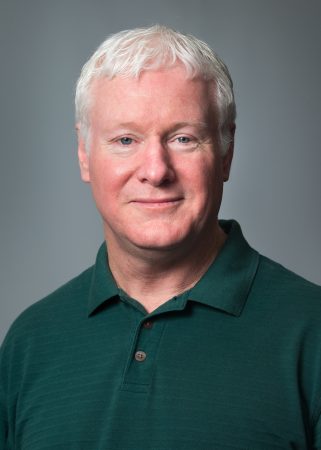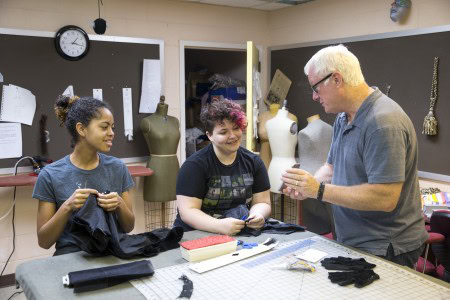Curtain Call: Theatre professor Ken Parks retires from Randolph after nearly two decades

Ken Parks
This story is part of a series featuring faculty members who are retiring in 2020.
Randolph theatre professor Ken Parks hadn’t really considered teaching as a career path until the late 1970s, when he was working at Nashville’s Academy Theatre and was asked to help out with its immersive summer program.
“We got high school kids to design, build, and fully produce a show each summer, and it was magical,” he said. “I found that sharing the craft and watching students get excited about theatre was even more fun, so I decided to move into teaching. Being a resident designer at a college where I could train and collaborate with emerging artists seemed like the best way to go.”
He found that opportunity at Randolph, where he arrived in 2001, and from where he will retire this year.
“I’ve gained a lot in my time here, from relationships built with fellow faculty, staff, students, and community members,” said Parks, who earned his undergraduate degree from Centre College of Kentucky and his M.F.A. from the University of Mississippi. “I hope that I’ve managed to give as much as I’ve received.”
What brought you to Randolph?
“I was looking for a place where I could contribute to the growth of something special in educational theatre, a production-focused program that would provide conservatory-style experiential training in a liberal arts environment. The Department of Theatre was expanding, and I was hired to head the design track. My colleague, Tom Stephens, was interested in building a company of artists who would work side-by-side with students as collaborators and that interested me very much. The intention was for classwork to support production as the central learning environment instead of the other way round.
“Teaching at larger universities and in the conservatory environment of CalArts convinced me that the smaller, liberal arts environment is the best laboratory for teaching theatre. Randolph was very similar to my undergraduate college, so I had a sense of how dynamic the student experience could be here and what I could contribute.”
Could you talk a little bit about where your interest in theatre came from, and how you knew it would become your life’s work?
“My first love was drawing and then photography, but I always had an interest in theatre. We would play out stories as kids, building environments in the woods and undeveloped fields at the edge of the neighborhood, immersing ourselves in them for weeks at a time. When I was introduced to films, I thought acting would be such fun because you could be all the different characters. So I jumped at the chance to take Experimental Theatre as a minor when I got into the Rhode Island Governor’s School on an art scholarship. That’s when I was hooked. I worked on every play I could from then on, onstage or backstage. But I still thought of myself as an art kid. My mission when I went to college was to work out whether I liked art or theatre better. That’s when I learned about design; I could do both at once. Perfect.”

Theatre professor Ken Parks reviews photos of the stage illusion tests with students Morgan Wardlaw ’17 (left) and Daisy Howard ’17.
What has it been like working with and guiding students into a field you’re so passionate about?
“The really thrilling thing is when a student realizes that the work is theirs and you see them become the artist instead of a student. That’s when it’s exciting. It’s exciting because they’re suddenly expressing out of their own perspective instead of just parroting back what they’ve learned and the collaboration becomes much more dynamic. It challenges me to become a better artist to keep up. There is always a lot to learn from a good collaboration. I’ve been privileged to share that experience with quite a few students here. That’s what has kept me growing as an artist for 20 odd years.
“Some have gone on to work in theatre while others have taken what they’ve gained from theatre into other occupations. What I hold to be true is that skills gained in theatre will benefit a person in any field they go into and that a theatre person is more prepared to succeed wherever their passion leads them. So it’s not about leading them into the field, but rather coaxing them towards discovering their own power.”
How has the theatre department evolved or changed during your years here?
“We expanded the production program, adding a studio season to produce as many as five shows in a season to meet growing interest in the program, and began producing musicals more frequently. To serve more majors, we opened opportunities for students to take leadership roles across the season where they routinely collaborate with guest artists as well as faculty and staff. We added the costume position to have more consistent training in that area. And we added the B.F.A. with a corresponding focus on professional training grounded in a broad exposure to the arts as well as the various disciplines of theatre.
“We forged working relationships with other arts programs—music, dance, art, creative writing—hand-in-hand with the development of the B.F.A. and the Fine Arts Colloquium. The colloquium particularly has brought faculty, staff, and students in the arts closer together as a community, which has, I think, enhanced all of our work.”
Do you have a favorite production or productions you worked on during your time at Randolph?
“I’ve had the pleasure to collaborate with Hiawatha Johnson, Jr. on several shows on campus and off. Co-directing Comedy of Errors with him was definitely a favorite. I have other favorites for different reasons; the harried excitement of designing Jem & I, with our guest playwright, Ron Fitzgerald, re-writing the script nightly. Challenging Paul Schreiner with the stage-spanning arches for Living Out and having him deliver beautifully. Playing Uncle Vanya opposite two senior actors at the top of their game, while designing lights in collaboration with our guest scenic designer from Bulgaria. Whatever show I worked on last.”
What’s your favorite memory from your time here?
“Making Morgan Wardlow disappear onstage. There are several, actually. Mentoring our first ever all-student design team for Savage in Limbo, working on lighting for Spring Awakening with Matt Cornpropst ’14 and then collaborating with him as he designed the lights for F’ing A. Performing as the ‘Brew Brothers’ with Hiawatha during The Show, twice.”
What’s next for you?
“Maybe I’ll finally get around to that novel. I’ve got a few things lining up, including some design work with a company in Northern Virginia that has been ramping up over the last while. Every day brings new possibilities. I don’t anticipate things winding down just yet.”

